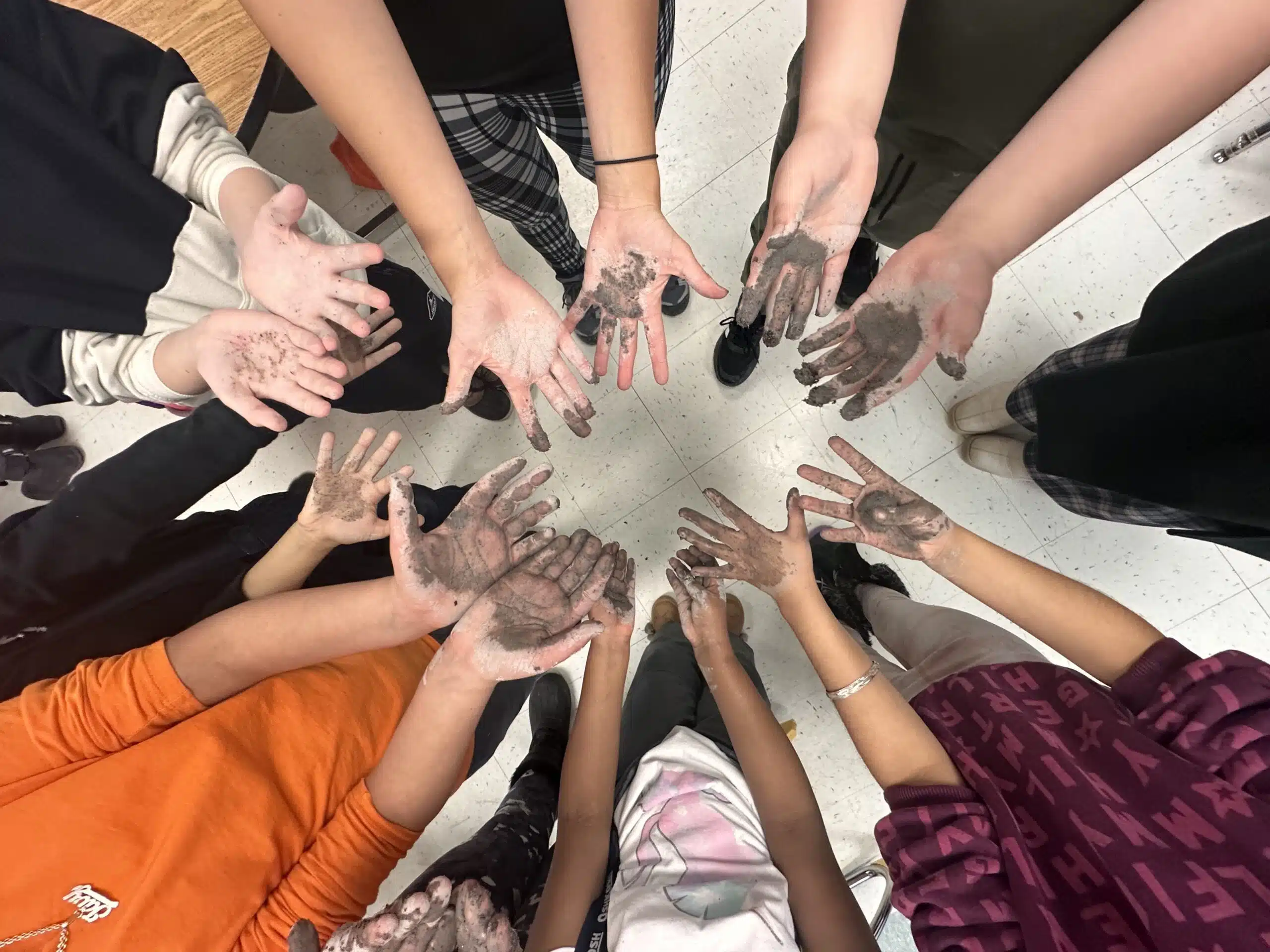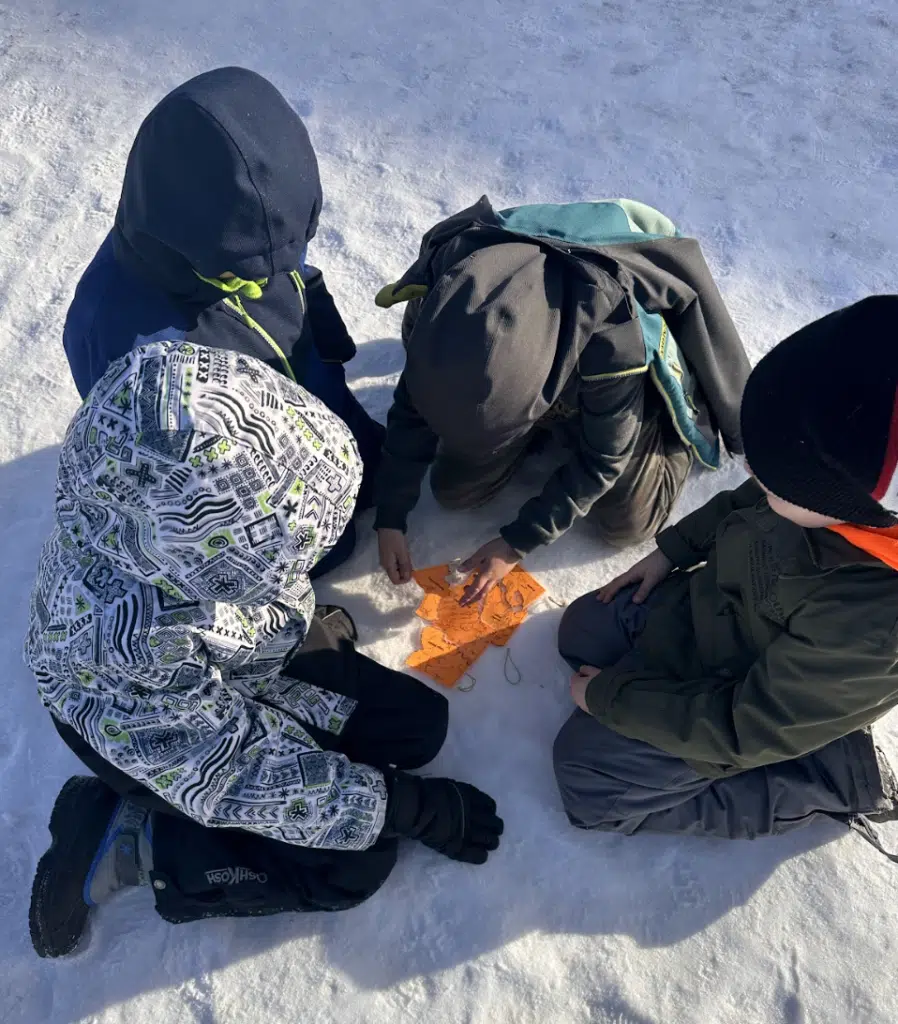
CPAWS Manitoba Environmental After School Programming Helps Children Get Outside and Appreciate the Wonders of Nature
by Katie Borgfjord, Digital Marketing Coordinator
A dozen children chased each other around their snow-covered schoolyard, pretending to be owls and grasshoppers as part of an after-school program aimed at connecting kids to nature.
“I love watching kids interact with their schoolyard in a different way than they have before,” said Environmental Educator Cary Gray.
“With games and guided questions, we shift their perspective of the schoolyard from the familiar play space to a learning space. Shifting how we view familiar places and taking time to connect with local nature helps deepen the student’s relationship to that place and the environment around them.”
The CPAWS Manitoba Afterschool Environmental Education program teaches children about the importance of nature and conservation through educational activities in their schoolyard or a nearby green space.
Students spend 90 minutes outside once a week for six weeks playing games and learning about Manitoba’s animals, plants, climate, trees, soil and more.
The program is tied to Manitoba curriculum outcomes and incorporates inquiry and hands-on learning, crafts, and group games.
“My daughter is in grade 2, and she loved it! She enjoyed all the activities,” said Bleszy Oyong, the parent of a Grade 2 student at Riverbend School.
The CPAWS Manitoba Environmental After School Program was launched in May 2022 at three schools in Winnipeg: Montrose School, Ecole Constable Edward Finney and Windsor School.
Since then, 24 more schools in Winnipeg and surrounding areas have invited CPAWS Manitoba to teach their students through the after-school program.
The purpose of the program is to deepen the educational experience for children beyond what CPAWS Manitoba offers through school workshops and field trips.
“We’ve built an amazing working relationship with Riverbend School, offering all of our programs there throughout the year,” Carly said. “We’ve hosted field trips, in-school programming, and after-school programming and they participated in our litter clean-up challenge. Students already knew about CPAWS programming and they were excited to participate again.”
The program was expanded to support a group of home-schooling families who gathered at Bunn’s Creek Park for 6 weeks in March 2024.

“I love that it fits in with the Manitoba curriculum because it expands on things we’ve already talked about,” said Rebecca Oakes, whose home-schooled children are 7 and 9 years old.
“The kids felt so comfortable with Carly. Usually, we have to go with them and follow them at other programs. She made them so comfortable and absorbed in the content.”
Children went for a nature walk around Bunn’s Creek Park, exploring the area. Afterwards, they met with their parents at the picnic shelter to learn more about water. They participated in water testing, comparing filtered water, snow, and water from the creek.
“I like the outdoor aspect, it gets my kids moving, and breathing in fresh air,” said Kerri Christenson, one of the homeschooling parents.
A Day in the Life of the Environmental After-School Program
On the last day of the program at Riverbend School, the focus and learning outcome was “Giving Back to the Land, reciprocity and symbiotic relationships.” Here is a look into one day of the student’s activities.

Land Acknowledgement
Activity: We explored the schoolyard to find different animal habitats to connect the students to the land we live on. Participants are invited to seek out something from, on, or of the land that they feel connected to. After they return, we participate in a land acknowledgement.
Learning Outcome: This reminds participants that humans are inherently connected to nature, and how this connection is universal and told through stories. These stories can be the ones we make today or the ones of the past. These stories and ways of knowing are embedded in the land we stand on. This is what it means to acknowledge land and the connection to land, this has been an eternal practice by Indigenous Peoples and is a diverse practice across nations.
Habitat Walk
Activity: The students Partnered up to play “Habitat I-spy.” We identified what an animal needs in their habitat: Food, water, shelter and space. Then we walked around to find things in the schoolyard that might be a good habitat for the burrowing owl.
Learning Outcome: Afterwards, the students discussed what we can do to be mindful of these habitats. We can plant native vegetation, be mindful when hiking through wild spaces as animals may have made homes in tiny places, learn about habitats to remember that animals also need to live in urban places and learn about local endangered species.
Endangered Species and the Food Chain
Activity: Students played “Wildlife Survival.” Students were assigned to be either a burrowing owl or, in their diet, a grasshopper. The grasshoppers were assigned to collect as many popsicle sticks (representing grass) as they could. Owls then tag the grasshoppers to collect their popsicle sticks. Then as a group they identified which grasshoppers had red sticks, if they had one, they were to “die.” They then learned that the red popsicle sticks represented pesticides, which affect the grasshoppers that eat the grass and the burrowing owls that eat the grasshoppers.
Learning Outcome: We discussed the impact of pesticide grass on burrowing owls. Carly then taught the group about the current status of burrowing owls in Manitoba. We discussed alternatives to using pesticides in the environment. Overall it shows the impacts of the food chain.
Manitoba Ecosystems
Activity: Students participated in an Ecozone relay race to find puzzle pieces that make up Manitoba ecosystems: the Prairies, the Boreal Forest, and the Taiga Shield.
Learning Outcome: We identified which ecozone we live in within Manitoba, and analyzed the impacts of the boreal shield and native prairie plants. These plants help the entire ecosystem, protecting prairie plants and their habitats. Students learned that we live in one of the most diverse ecosystems and also one of the most endangered. What can we do to preserve prairie habitats?
Preserving Prairie Habitats
Activity: Lastly, we ended the program by getting messy and creating seed balls! To make seed balls we mixed powdered clay, soil, water, and Joe Pye seeds (a native prairie plant), and rolled them into balls.
Learning Outcome: This taught them that land is a gift and that we can give back to the land with our seed balls! This teaches students to understand the importance of planting native species and growing mediums and how to plant seeds.
CPAWS Manitoba taught 16,797 children and students about Manitoba’s wildlife and natural wonders through 857 place-based outdoor education workshops, field trips and activities from May 2021 to March 31, 2024.
How to Book an Afterschool Program
Learn more about CPAWS Manitoba’s environmental education programming here.
Are you interested in booking CPAWS at your school? Reach out to [email protected].
